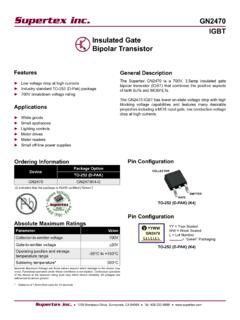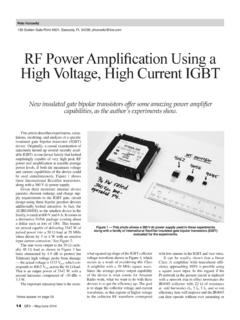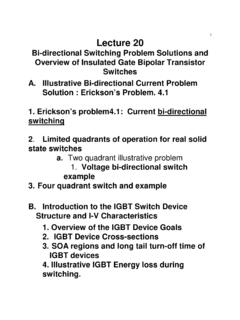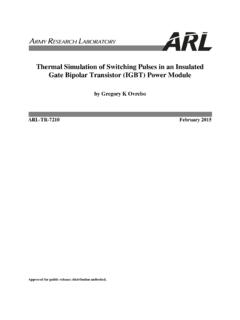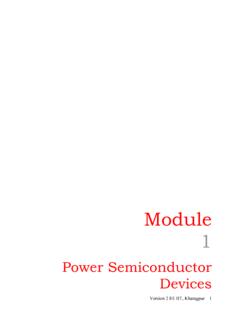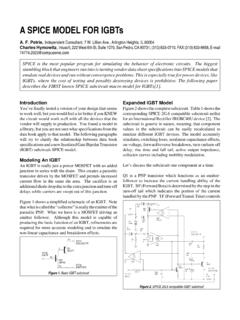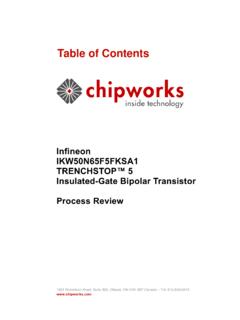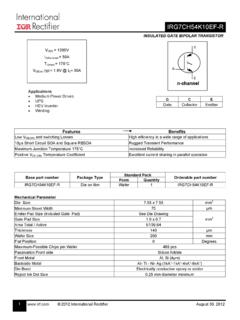Transcription of Half-Bridge Converter with the Insulated Gate Bipolar ...
1 Volume 47, Number 1, 2006 35 Half-Bridge Converter with the Insulated gate Bipolar Transistors Gheorghe B LU and Alexandru MORAR Abstract- A reversible drive system, which employs a four-quadrant chopper with the Insulated gate Bipolar transistors (IGBT), is presented. The chopper circuit employs a Half-Bridge configuration. The operation of the Converter was tested at a command frequency of [1 10] kHz. Except at very high power levels, the four-quadrant chopper has certain advantages such as high operational frequency, smooth and linear control, high efficiency and fast response. Keywords- Half-Bridge chopper, IGBT gate drive circuit, PWM command, motor. 1. Introduction The appearance of power transistors with Insulated gate IGBT ( Insulated gate Bipolar transistor ) lead to the necessity of redesigning the power converters structure from the point of view of the gate command and protection circuits [1], [2].
2 The IGBT advantages are: very high input impedance (voltage controlled device), low level of loses in conduction state, low switching loses, high operating frequency (up to 50 kHz), simple protection circuits. They have also a wide area of application from the power point of view 5W 500 kW with a switching frequency over 25 kHz, the currents being over 600A and the voltages around [1600 1700]V. These parameters might become soon obsolete. Taking into account ideas presented above, the authors present in this paper a Half-Bridge Converter designed using Insulated gate Bipolar transistors and dedicated to supplying the separately-excited motors. 2. Four-Quadrant Chopper Such supplies can be found in many industrial processes, transportation systems, chemical and steel plants etc.
3 Except at very high power levels, the four-quadrant chopper has certain advantages such as high operational frequency, smooth and linear control, high efficiency and fast response [1]. The block diagram of the achieved control system is shown in Fig. 1. The Converter is a Half-Bridge chopper with four-quadrant operation. The hardware configurations of the chopper where the snubber and gate drive circuits are also included. The voltages ui(t) and ue(t) from the reversible chopper s input and output are presented in Fig. 2. On the hypothesis of perfect semiconductors use, the average value of the output voltage is given by: )12(U)1Tt2(Udt)t(uT1 UnT01nim = = = (1) where: T = the chopper period, t1 = the duration of conduction, Un = the motor s nominal voltage and = the duty cycle.
4 From equation (1) it follows that for = 50%, the voltage on the load circuit is purely alternative, the continuous component being zero. For 50%< <100%, the voltage applied is positive, continuous and it can be modified between 0 and Un, for 0%< <50%, the voltage has the same limits, but in negative domain (Fig. 2b). ACTA ELECTROTEHNICA 36 SNUBBER ~220VV+V+D1uGSIGBT1GD2C1R1D4R2D3 IGBT2S PWM1 ~220 VPWM1 PWMV+PWM2V+PWM2 GNDuGSGSC4 SNUBBER DIGITALPARTLfGENERATORPWMV+P1(DUTY CYCLE)OPTICAL ABNMLOADENCODERC2C3+C5C6+V+V-LEM1 (LA25-NP)LEM2 (LA25-NP)f1f2f9f10f11 IIGBT2(PROT2)IN2 IIGBT1(PROT2)IN1 DRIVERIGBT1 DRIVERIGBT2(FREQUENCY)Kfi(t)n(t)u (t)eu (t)i+-ExF2F1 Fig. 1. Block diagram of drive system. +Un0 IGBT1-ONIGBT2-ON-UntLH(PWM)t1t2Tu (t)ii(t)ImaxImminIUmttu (t)e [%]1000+Un-Un50clockwiseanticlockwiseUm a. b.
5 Fig. 2. Logic timing diagram for Half-Bridge Converter . 3. IGBT gate Drive Circuit For the IGBT command, a positive voltage is needed for charging the input capacity at the transistor s switching on. The switching off can be done with a negative voltage [1], [2]. The main problem for the switching on is the assurance of a sufficient current during the period of the switching on in order to charge the input capacity in an imposed time. The IGBT switching off begins immediately after the gate -source voltage becomes zero. The switching speed is again limited by the discharging slope of the input capacity through the driver circuit. In Fig. 3 it is presented the electric schematic for the IGBT gate drive circuit [3]. The IGBT can be found as a single component per device or as a module with one, two or six discrete components in the same device, the recovering diodes being included in most of the cases.
6 The authors used a module with one IGBT, without diode IRGBC40F (160W, 600V, 49A, International Rectifier), which offers flexibility, the user having the possibility to choose any of schematic [7]. The galvanic isolation between the gate drive circuit and the digital command part is provided by a HP2212 opt coupler (Hewlett Packard). Among the features of this opt Volume 47, Number 1, 2006 37T4R3T2+15VD1 VIVOCOMPR~TRF1220V50Hz~C2C1C3C4R1R2T3 BC5C6R4D3D2T5 UGST1T8R8R9AV+R6C7C8C9C10 C11R7T6T7T9 R10CR11C12C13T10T11D4 COMOPTO-ISOLATORR6 VIVOCOMI2 LM7909I1 LM7815-9VI3T12R12D5C14T13D6R14R13 VZDESATURATIONFAULT DETECTIONCIRCUIT MODULELEM(PWM)IGBTFig. 3. IGBT gate drive circuit. coupler, it can be mentioned here: TTL, LSTTL and CMOS compatible, propagation time better than 150ns, wide supply range ( to 20 volts), low input current ( ) [5].
7 The proposed gate drive circuit achieves the voltage Bipolar command of the Insulated gate Bipolar transistor T5. The circuit contains two complementary MOS transistor T4 with P-cannel IRF9540 (UDS=-100V, RDS(ON)= , ID=-19A, PD=150W) and T11 with N-cannel IRF540 (UDS=100V, RDS(ON)= , ID=28A, PD=150W) [8]. When the P-cannel transistor is switched on the IGBT is commanded with a positive voltage (+12V) and the N-cannel transistor is switched on the IGBT is switched off with a negative input voltage (-9V). The command of the MOS transistors is achieved with complementary Bipolar transistors: T2 (npn) and T3 (pnp) on one hand and T9 (npn) and T10 (pnp) on the other hand. The transistors T6 and T7 are used for the amplification of the signal obtained of the optocoupler s output.
8 Figure 4 shows the electric schematic of the digital command part. Two complementary PWM signals, PWM1 and PWM2, with dead time are achieved by a simple combinational logic (Fig. 5). The dead times were obtained using the monostable I1 and I2 (MMC4047) and the RTCT assigned circuits. The main elements of the overload protection circuits are two Hall transducers-LEM modules, which have very high performances (Fig. 6) [3], [6]: the electronic measurement of currents: , , impl., etc., with galvanic isolation between the primary (high power) and the secondary (electronic) circuits; global precision: 10% of nominal current; response time: better than 1 s; bandwidth: 0 150 KHz; linearity: better than The output of each current measurement channel contains two CMOS signals for protection (PROT1, PROT2), which become active when the current through IGBT overpass the imposed limit for each sense.
9 ACTA ELECTROTEHNICA 38 I3 AMMC4011 PWM +15 VRTRTCT +15 VCTI3 BMMC4011 R2T2 I4 BMMC4001I3 CMMC4011 +15V C2C1 QOSCI1 MMC4047 DDV-ASTT+TRETRCCCXRXRSTASTSSVQAQOSCI2 MMC4047 DDV-ASTT+TRETRCCCXRXRSTASTSSVQ+15 VRESETBCDEI4 AMMC4001 PROT1 PROT2+15VV+PWM2 F GR1T1 PWM1I4 CMMC4001H(DEAD-TIME) Fig. 4. Logic block diagram for digital command part. PWMACBDIGBT1 ONEPWM1 PROT1 PWM2 PROT2 DEAD-TIMEIGBT2ON Fig. 5. Logic timing diagram for digital command part. +- R8R4 UR2I1A+15VR6-C1+I1BI1CR9 PROT1I2A--15V+C2R3R1LA25-NPV+IpIsLEM MODULE +15V -15VV-*UA PROT1-UHL+U0+10V-10V+15VR5-15VR7 UBUCMMC4093 TLO84R5=R6=R7[-10V;+10V]UA+15V+15V+15V-1 5 VUUBUC+15V0 VLHPROT10VH-15V +15V(-15V; -10V)(+10V; +15V)R8=R9 +10V-10V Fig. 6. IGBT protection circuit. Volume 47, Number 1, 2006 39 Fig. 7. The experimental laboratory system. 4. The Experimental Laboratory System The experimental research was performed in Electrical Drives Laboratory from the Electrical Engineering Faculty, Technical University Gh.
10 Asachi of Ia i, where it was achieved an electrical drive system using separately-excited motor. In Fig. 7 is presented the general view of developed system [4]. The electric motor uses permanent magnets and has the following nominal parameters: Pn=100W, Un=24V, In= The motor is loaded using an identical machine, which operates in a braking mode. In Fig. 8 there are presented the command complementary PWM signals for the case of a working frequency of 5 kHz. The imposed dead-time is 25 s. The figures from 9 to 11 present the armature voltage and current waveforms under the following working conditions: working at clockwise electrical drive motor, =90% (Fig. 9); resting motor, Fig. 9. Armature voltage and current waveform (clockwise).
